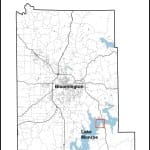Local prosecutor charges two in July 4 Lake Monroe case, victim wants feds to prosecute as hate crime


Two weeks ago on July 4, an incident took place in the woods at Lake Monroe. Vauhxx Booker has described his role in that incident as “almost the victim of an attempted lynching.”
On Friday morning, county prosecutor Erika Oliphant announced that she had filed charging documents in the Monroe circuit court about two people in the incident.
The filing of charges was based on the investigative report and evidence given to the prosecutor’s office by the Indiana Department of Natural Resources (DNR), which handles law enforcement for Lake Monroe public land.
Sean M. Purdy is alleged to have committed criminal confinement, battery resulting in moderate bodily injury, and intimidation—all felonies. Jerry Edward Cox II is alleged to have committed aiding, inducing or causing criminal confinement, battery resulting in moderate bodily injury, and intimidation. Those are all felonies. Cox is also alleged to have committed two misdemeanor batteries.
At a Friday afternoon press conference, conducted on the Zoom video conferencing platform, Booker and his attorney, Katherine Liell, gave an update on the status of the FBI investigation. “We continue to cooperate with the FBI—we trust them more than we trust DNR. And so Vauhxx has already submitted to quite a lengthy interview.”
Liell said there could be a delay in the FBI investigation, because of the confirmed positive COVID-19 test that Booker had received a few hours earlier on Friday morning. He received the test result while he was chairing the county’s affordable housing advisory commission meeting, Liell said. Booker also serves on the county’s human rights commission.
Liell said that Booker was tested for COVID-19, because the suspects in the July 4 incident were “spitting and yelling in his face.” The test was done on July 15, Liell said.
The hoped-for outcome of the FBI investigation is prosecution for violation of federal hate crime laws. At Friday’s press conference, Booker said, “This is about justice, and part of that is going to be the need to move on to the federal level.”
Liell pointed out that Indiana Code allows a crime to be classified as a “bias crime,” if the person “commits the offense knowingly or intentionally…selected the person who was injured…by the offense because of the color, creed, disability, national origin, race, religion, or sexual orientation of the injured person.”
If someone is convicted of a crime that’s analyzed as a “bias crime,” the prosecutor can argue that it is an aggravating circumstance for the judge to consider when determining a sentence. That includes consideration of a longer sentence, up to the maximum allowed. Aggravating circumstances can also be used to argue for the “stacking” of sentences for separate offenses—so that they must be served one after the other, instead of concurrently.
If Purdy is convicted, and the maximum sentences are given to him, and the sentences are stacked, he would be looking at serving 11-years in prison, according to Liell’s calculation. Purdy Cox could be facing 12 or 13 years, Liell said.
The probable cause affidavit for the arrests, which was produced by the DNR, mentions the allegations of a call for a noose, when Booker was being held down, and allegations that “white power” was shouted sometime during the day.
But the affidavit does not include some of the other possible evidence that would indicate a bias crime or a hate crime. That’s one reason why Liell and Booker say they don’t trust the DNR.
Even though Booker told DNR officers that Purdy was wearing a hat with a Confederate flag, and Purdy had admitted to it, there’s no mention of the Confederate flag in the affidavit, Liell said. Also missing from the affidavit, Liell said, are “all the terrible racial epithets which were hurled against Vauhxx Booker, which we all saw on tape.”
Liell called the affidavit “deficient,” but allowed that it was good enough to get felony charges filed.
Another reason Liell gave for not trusting the DNR stems from the DNR’s public release of its report, just after turning it over to the Monroe County prosecutor’s office.
The DNR report includes on a list of “potential crimes committed” some by Booker—battery and criminal trespass.
The public circulation of the DNR’s report came after a Wednesday late afternoon press release from the prosecutor’s office had news of a development in the case: The investigative report and evidence from the DNR had been received by the prosecutor’s office, according to the two-sentence news release.
On Thursday, stories based on a redacted version of the investigative report started showing up in various news outlets. When The Square Beacon asked the local prosecutor’s office for a copy, a response came back declining: “Our long-standing office policy (spanning at least 3 administrations) is that we do not release agency reports (except through the discovery process), because they are their reports, not ours.”
Normally, such reports, as “investigatory records of law enforcement,” are exempt from required disclosure under Indiana’s Access to Public Records Act (APRA).
Liell said she was not provided with a copy of the report by the DNR—she’d read about it in the IndyStar.
The Square Beacon emailed the DNR asking if the report was intentionally released, if so why, and requested a copy of the report. The response from the DNR was to provide a copy of the report. The Square Beacon did not receive a response from the DNR to a followup, asking if the agency’s initial release had been made in response to a request under Indiana’s APRA, or if it had been pushed out to a standard media list.
Responding to a question at Friday’s press conference, Liell attributed the willingness of the DNR to release the report to the misclassification of its case status, which appears in the header of each page: “CLEARED BY ARREST”
No arrests had been made by Thursday, when news reports about the DNR report started appearing.
Liell said, “I believe DNR intentionally misclassified the status of the report in order to release it, and preempt the charges that were being considered by the Monroe County prosecuting attorney’s office.” Liell also thinks the DNR released the report in order to “malign the character of Vauhxx Booker” by suggesting he had committed battery.
She called the release, “more than shameful,” and said the misclassification of the case status—so that the report could be released—should be investigated.
The report’s listing of a potential crime of battery by Booker was based on the statements of witnesses who said that Booker punched people. Asked at Friday’s press conference if Booker had punched Purdy or Cox, Liell said, “I believe that during the time that Mr. Booker was being attacked by all three men that indeed he was trying to protect himself. Whether he actually made contact with anyone, I don’t think even Mr. Booker knows at this time.”
Liell added, “But he knows that he was trying to protect himself when they were wrestling on the ground, before they were able to pin him against the tree.”
Video footage of the incident posted on Facebook and other social media shows Purdy holding Booker down against a tree.
The DNR investigative report chronicles a couple of followup visits to the site, in an attempt to locate the specific tree where Booker was held down. The report gives the latitude and longitude of the tree, determined by the DNR to be the one where Booker was held down.
The report concludes that the tree is on the public side of the property line, between public land and property owned by Purdy’s girlfriend, Caroline McCord. That’s consistent with a Square Beacon plot of the coordinates using Monroe County GIS property records.
The potential crime of trespass by Booker, listed in the DNR report, appears to have been based on the apparent crossing of private land at other times during the day.





Comments ()